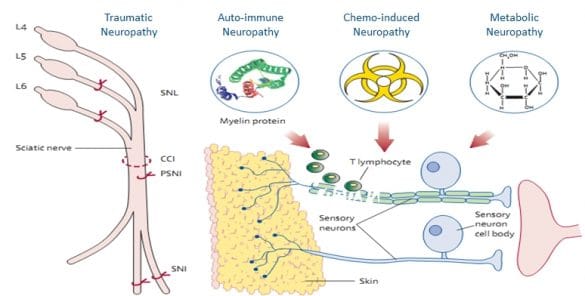
ANS Biotech has established robust and relevant in vivo models for neuropathic pain in order to help you to select and validate your compounds in this challenging field.

- CHRONIC CONSTRICTION INJURY (CCI MODEL – BENNETT MODEL)
Mechanical hyperalgesia (paw pressure test)
Mechanical allodynia (electronic Von Frey test)
Tactile allodynia (Von Frey hairs test)
Thermal allodynia (paw immersion test)
- SPINAL NERVE LIGATION (SNL MODEL – CHUNG MODEL)
Mechanical allodynia (electronic Von Frey test)
- SPARED NERVE INJURY (SNI MODEL)
Mechanical hyperalgesia (paw pressure test)
Mechanical allodynia (electronic Von Frey test)
- DIABETIC NEUROPATHY (STZ MODEL)
Mechanical hyperalgesia (paw pressure test)
Mechanical allodynia (electronic Von Frey test)
- CHEMOTHERAPY-INDUCED PERIPHERAL SENSORY NEUROPATHY (OXALIPLATIN MODEL)
Cold allodynia (Paw immersion test)
Neuropathic Pain (NP) is one of the most difficult types of pain to treat in humans and is characterized by long-lasting exaggerated pain behavior such as hyperalgesia and allodynia in animals. It can be studied in primates and other mammals but rodent models are by far the most widely used. The majority of the preclinical models are based on a discrete peripheral nerve injury and can be related to post-traumatic / postsurgical neuropathic pain experienced by patients. In research, mechanical nerve injury can result from acute or chronic nerve ligation or more severely by the partial or complete severing of a nerve.
ANS Biotech offers several mechanical nerve injury models that have proven their usefulness in the experimental study of NP in rodents. In these various models, nerve roots can be ligated (or severed), the sciatic nerve can be partially ligated or a chronic constriction can be placed around it. Also nerves emanating from the sciatic (tibial and common peroneal nerves) can be ligated (or severed). These procedures have in common that the innervation of the foot remains partially intact, allowing tests for allodynia and hyperalgesia to be done.
Mechanical trauma is not the only way a nerve can be injured. Injury can also occur as a result of a metabolic disorder (diabetes), chemically induced nerve trauma, infection (postherpetic neuralgia) or autoimmune disorders.
ANS Biotech also proposes other models of NP that more closely mimic individual disease states such as painful diabetic neuropathy and chemotherapy-induced peripheral neuropathy.
Several diabetic models are available but the most commonly used model for the study of pain is the Streptozotocin-induced diabetic NP model (STZ model). This model has been used extensively for testing new compounds such as gabapentin and pregabalin.
In chemotherapy, the cumulative dose-limiting toxicity is a major problem due to the painful neuropathy induced by antineoplastic agents. When preclinically administered, these chemicals also produce sensory neuropathies consistent with those reported in patients. This is the case with Oxaliplatin-induced cold allodynia.
You may also be interested in this article: “FOCUS ON OXALIPLATIN-INDUCED PERIPHERAL NEUROPATHY: MECHANISMS AND PHARMACOLOGY“.
